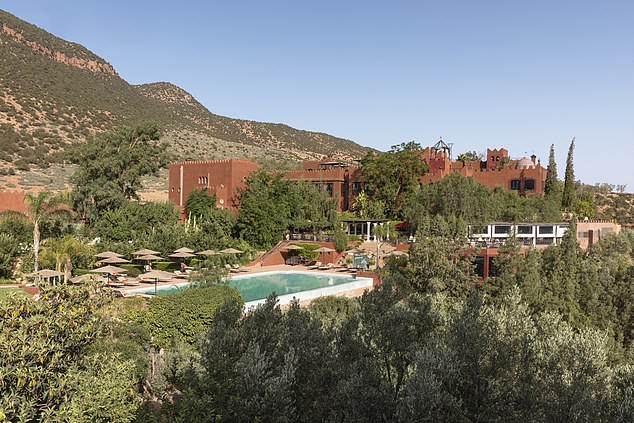Shortly after 11:00 p.m. on September 8 last year, Morocco’s High Atlas Mountains were shaken by an earthquake measuring 6.8 on the Richter scale, the strongest ever to hit the North African kingdom. in 120 years.
Nearly 3,000 people were killed, 19,000 homes were destroyed and 60,000 suffered significant damage. The worst effects were in mountain towns, but even buildings were demolished 45 kilometers away, in Marrakech.
Also severely affected was Kasbah Tamadot, Sir Richard Branson’s boutique hotel in the foothills of the High Atlas.
“I’ve seen pretty much everything: hurricanes, fires, earthquakes, diseases, you name it,” says Sir Richard. ‘My approach is that the next day I take out a big sheet of paper and plan how we can come back better and stronger than before. As long as you think positively, you can leave these things behind.’
And so it proved when I arrived for the official reopening of this ancient Berber fortress, which dates back to the early 20th century.
Neil Darbyshire attends the official relaunch of Kasbah Tamadot (pictured), Sir Richard Branson’s Moroccan hotel
The Virgin boss, now 74, bought Tamadot in 1998 on the instructions of his formidable mother, Eve, who fell in love with the place when her son was on one of his balloon adventures in Morocco. “She would have disowned me if I had said no,” he says.
Located on a promontory less than an hour’s drive from Marrakech, the decor is inspired by the Berber people, nomads who came from the Sahara and ruled here before the Arab conquest.
At 4,330 feet above sea level, it sits at a similar height to the summit of Ben Nevis, so it’s hardly bleeding territory. But the air is thin and clean and the temperature a few degrees lower than in Marrakech, a blessing in the height of summer.
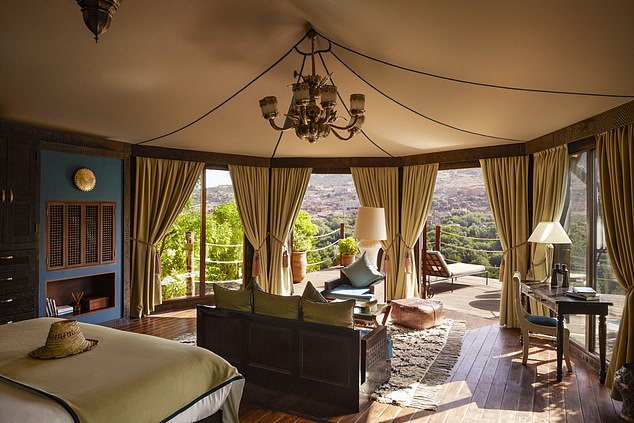
Neil stays in one of the hotel’s ‘Berber’ tents (seen here). He says they are “considerably more sumptuous and certainly more solid than anything the Berbers could have imagined.”
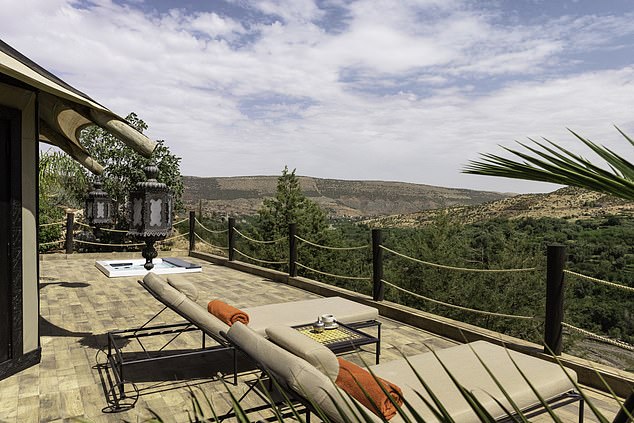
The tents have sun terraces “overlooking the steep river valley”, writes Neil
Keeping up with Sir Richard is no easy task. While he marches through the Kasbah at a military pace, we remain in his wake. By the time you catch up with him in one place, he’s already running to the next. The main fortress is a series of interconnected crenellated towers, built around an open square courtyard.
There are rounded Islamic arches, elegant water fountains and a rooftop terrace for those wishing to dine al fresco.
To the rear there are large grounds with an infinity pool, two restaurants and many corners.
There are secluded Berber “tents” with terraces overlooking the steep river valley and six traditional riads with three bedrooms, private pools and rooftop terraces.
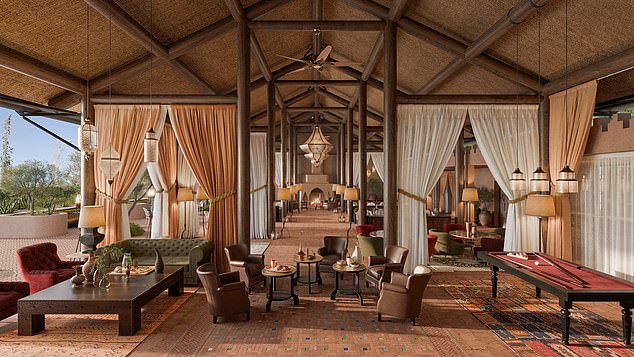
Above, Tamadot’s new restaurant, Asayss, former cow barn
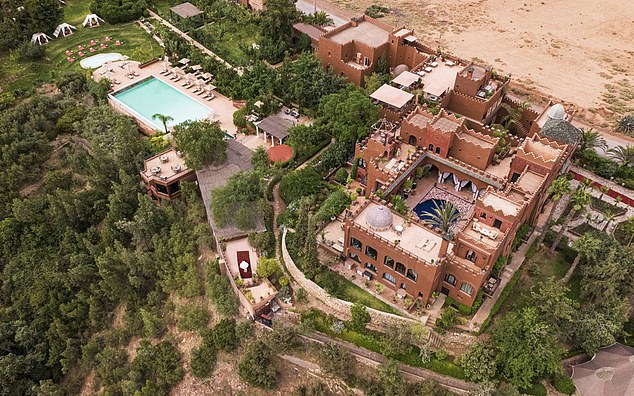
Neil reveals that Sir Richard bought the property in 1998 on the instructions of his mother, Eve.
I am staying in one of the tents, which are considerably more sumptuous and certainly more substantial than the Berbers could have imagined. It is a driver and a full nine iron distance from the main reception, very well hidden.
Since the earthquake, riads and the impressive high-ceilinged Asayss restaurant (formerly a cow barn) have been added. Only the library was left beyond repair and converted into an arched inner courtyard with a reflecting pool.
Sir Richard invites a group of us to join him on a bike ride, but I break off and take a more leisurely hike up the mountain with a guide, Abdul. We meet in Imlil, a city made up of 12 Berber villages about a 20-minute drive from Tamadot.
Looking down the valley from 6,500 feet, the effects of the earthquake are still clearly visible. There are obvious gaps where houses once stood. “Only about 60 houses were destroyed here, but almost all of them suffered cracks,” Abdul says. “We’re about to get back to normal.”
Imlil is the base for hikers, mountain bikers and climbers. From here we can see the upper slopes of Mount Toubkal, at 13,670 feet, the highest peak in North Africa. If you have three days to spare and some climbing experience, Abdul will guide you to the top.
Sir Richard, of course, has escalated it. After all, he saw Everest from a hot air balloon, plumbed deep ocean trenches, and rode a rocket to the edge of space.
But Tamadot is her passion project, and Eve Branson, who died from Covid-19 complications during the pandemic, loved this place. Her influence is still evident today: she created local schools to teach English and crafts such as knitting and embroidery, which provided skills and employment.
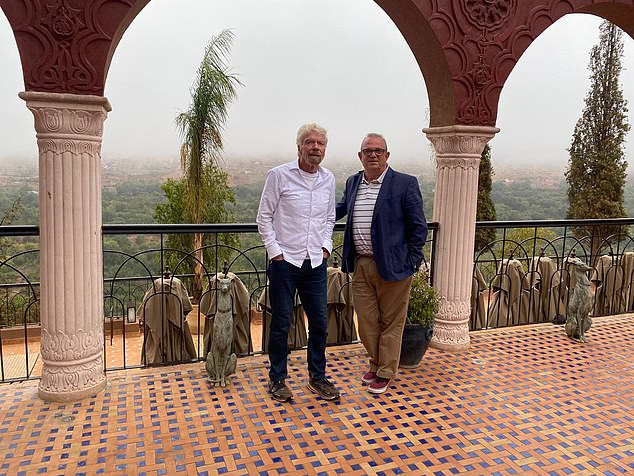
Neil pictured above with Sir Richard, who is said to be treating the hotel as his “passion project”.
Tamadot isn’t cheap and there isn’t much to do outdoors if you’re not the walking or cycling type. But two or three nights of pampered luxury within a larger holiday to Marrakech and perhaps Essaouira, three hours away on the coast, would be a real treat.
Sir Richard was one of the first to arrive after the earthquake, providing tents, food, water and other aid to the affected villages.
“I think of this community as a family,” he says. It shows, and your mother would be delighted.
It’s a great drama in the High Atlas.
The Moroccan village of Ait Ben-Haddou once made money from the salt trade. Today, much of its income comes from blockbuster movies filmed within its walls.
Both the original Gladiator and Gladiator 2, which opens in UK cinemas this week, were filmed here after an arena was built from traditional mud bricks to blend in with the existing architecture.
But Ait Ben-Haddou, a 30-minute drive from the city of Ouarzazate, is also a UNESCO World Heritage Site.
Upon entering there is an intricate labyrinth of alleys, with shops selling the same type of goods as in the souks of Marrakech. These are located next to traditional houses and stables that house animals.
It’s not just Gladiator that was filmed here. Scenes from Lawrence of Arabia, Game of Thrones and The Mummy also feature its buildings and dirt streets. My guide Mohammed works as an extra when the film crews arrive, and on a quick tour of his house he proudly shows off the sword and shield he wielded in Game of Thrones.
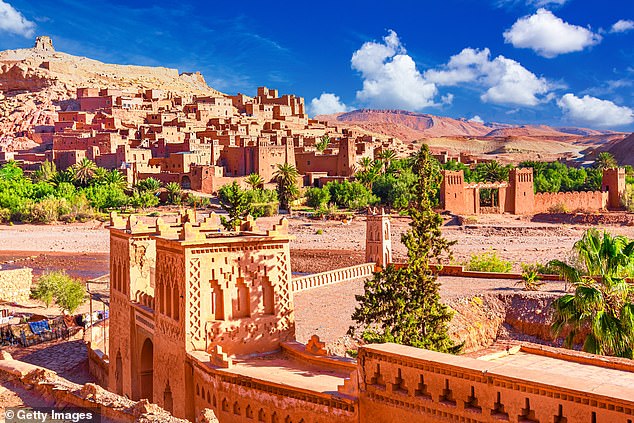
Hollywood Hills: The Moroccan village of Ait Ben-Haddou (seen here) has been used as a filming location for Gladiator and Gladiator 2.
Ouarzazate itself is known locally as Ouarzawood because it is home to one of the largest film studios in the world: Atlas Studios. Opened in 1983, the studio flourished and has since played host to Hollywood’s great and good, including Samuel L. Jackson, Brad Pitt, Nicole Kidman and Leonardo DiCaprio.
Many tourists make the four-hour trip here from Marrakech, but I flew directly to Ouarzazate as part of a week-long trip following the traditional caravan route to the Sahara.
Leaving the world of cinema behind, I leave the city towards Fint Oasis.
Even at the height of the summer drought, this tranquil, lush place has pools of water on the tree-lined riverbed, where local women wash their clothes before drying them in the bushes.
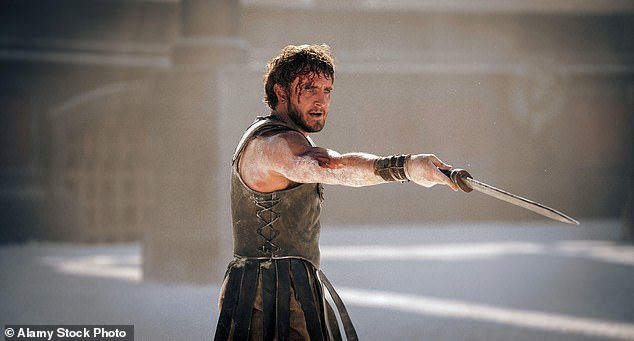
Above, Paul Mescal in Gladiator 2, which opens in UK cinemas this week.
Continuing on I reach the impressive Todra Gorges, a series of limestone canyons with cliffs rising to almost 300 meters (1,000 feet), and that afternoon I arrive at Merzouga, gateway to the Sahara, where I stay at Riad Serai .
This great sea of dunes is formed by sand blown by the wind, and in the distance I can barely make out a silhouette of camels with riders. The next day, a 4×4 takes me deep into the desert to spend a night in a luxury camp.
Along the way we stop and look for fossils, and within minutes I find an ammonite. Then, upon arriving at the camp, I am greeted with Moroccan mint tea and taken to my tent, complete with air conditioning, a bathroom and a comfortable bed.
As we sit around the campfire listening to live traditional music, I walk away and lie on my back looking at the night sky. I’m told the chance of seeing a meteor is high, and minutes later a shooting star traces a path directly overhead.
The film directors of Ait Ben-Haddou would give anything to capture this spectacle, but for now it is all mine.
By Sara Veness

